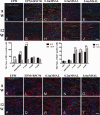Salidroside promotes sciatic nerve regeneration following combined application epimysium conduit and Schwann cells in rats
- PMID: 32053008
- PMCID: PMC7158595
- DOI: 10.1177/1535370220906541
Salidroside promotes sciatic nerve regeneration following combined application epimysium conduit and Schwann cells in rats
Abstract
Schwann cell and nerve conduit are crucial for nerve regeneration and re-myelination after peripheral nerves injury. To investigate the effects of Salidroside on autogenous epimysium conduit mixed with BD matrigel and RSC96 Schwann cells on an animal model with 5 mm sciatic nerve defect injury in rat, motor function, muscle reinnervation, immunohistochemical staining, retrograded tracing and Western blot were used in this study. The results showed that Salidroside enhanced the compound effects of epimysium conduit mixed with BD matrigel and RSC96 Schwann cells to improve the sciatic functional index and the gastrocnemius muscle weight ratio, which were better than EPM group at 8 weeks and 12 weeks post operation. Immunofluorescence and Western blot results of P75NTR showed that Salidroside improved the sciatic nerve regeneration, and retrograded tracing of CTB-Alexa 488 also supported that Salidroside was better to promote CTB tracer transporting from the distal nerve defect to the ipsilateral dorsal root ganglion and ventral horn of L3-L5 spinal cord on post-operation 8 weeks and 12 weeks. Our results demonstrated that Salidroside improved the effect of autogenous epimysium conduit mixed with BD matrigel and RSC96 Schwann cells on sciatic nerve regeneration in our study.
Impact statement: Peripheral nerve injury and regeneration remain a major challenge. Although nerve conduit and Schwann cells have been used to study the nerve regeneration, our results demonstrated that Salidroside improved the regenerative effect in a rat model with sciatic nerve injury model, following a combined application of autogenous epimysium conduit mixed with Schwann cells. Different concentrations of Salidroside combining autogenous epimysium conduit and Schwann cells were applied to compare the epimysium conduit group and the epimysium conduit combining Schwann cells group. Based on the results of motor function and muscle reinnervation evaluation, as well as neuronal tracing and expression of P75NTR, our study for the first time suggests that Salidroside may improve the regeneration effect on the sciatic nerve following a combined application of epimysium conduit and RSC96 Schwann cells in rats.
Keywords: RSC96 Schwann cells; Salidroside; autologous epimysium conduit; combination application; nerve regeneration; sciatic nerve injury.
Figures






Similar articles
-
Curcumin accelerates the repair of sciatic nerve injury in rats through reducing Schwann cells apoptosis and promoting myelinization.Biomed Pharmacother. 2017 Aug;92:1103-1110. doi: 10.1016/j.biopha.2017.05.099. Epub 2017 Jun 12. Biomed Pharmacother. 2017. PMID: 28622711
-
[EXPERIMENTAL STUDIES ON EFFECTS OF SALIDROSIDE/COLLAGEN/ POLYCAPROLACTONE NERVE GUIDE CONDUITS FOR REPAIRING SCIATIC NERVE DEFECT IN RATS].Zhongguo Xiu Fu Chong Jian Wai Ke Za Zhi. 2016 May 8;30(5):634-640. doi: 10.7507/1002-1892.20160127. Zhongguo Xiu Fu Chong Jian Wai Ke Za Zhi. 2016. PMID: 29786309 Chinese.
-
Synergistic effects of micropatterned biodegradable conduits and Schwann cells on sciatic nerve regeneration.J Neural Eng. 2004 Sep;1(3):151-7. doi: 10.1088/1741-2560/1/3/004. Epub 2004 Sep 10. J Neural Eng. 2004. PMID: 15876634
-
Transplantation of Schwann cells in a collagen tube for the repair of large, segmental peripheral nerve defects in rats.J Neurosurg. 2013 Sep;119(3):720-32. doi: 10.3171/2013.4.JNS121189. Epub 2013 Jun 7. J Neurosurg. 2013. PMID: 23746104 Clinical Trial.
-
Salidroside promotes peripheral nerve regeneration based on tissue engineering strategy using Schwann cells and PLGA: in vitro and in vivo.Sci Rep. 2017 Jan 5;7:39869. doi: 10.1038/srep39869. Sci Rep. 2017. PMID: 28054637 Free PMC article.
Cited by
-
MiRNA-206 Affects the Recovery of Sciatic Function by Stimulating BDNF Activity through the Down-regulation of Notch3 Expression.J Musculoskelet Neuronal Interact. 2023 Mar 1;23(1):109-121. J Musculoskelet Neuronal Interact. 2023. PMID: 36856106 Free PMC article.
-
Salidroside suppresses the activation of nasopharyngeal carcinoma cells via targeting miR-4262/GRP78 axis.Cell Cycle. 2022 Apr;21(7):720-729. doi: 10.1080/15384101.2021.2019976. Epub 2022 Feb 27. Cell Cycle. 2022. PMID: 35220889 Free PMC article.
References
-
- Ciaramitaro P, Mondelli M, Logullo F, Grimaldi S, Battiston B, Sard A, Scarinzi C, Migliaretti G, Faccani G, Cocito D; Italian network for traumatic N. Traumatic peripheral nerve injuries: epidemiological findings, neuropathic pain and quality of life in 158 patients. J Peripher Nerv Syst 2010; 15:120–7 - PubMed
-
- Chrzaszcz P, Derbisz K, Suszynski K, Miodonski J, Trybulski R, Lewin-Kowalik J, Marcol W. Application of peripheral nerve conduits in clinical practice: a literature review. Neurol Neurochir Pol 2018; 52:427–35 - PubMed
-
- Jiang Z, Song Y, Qiao J, Yang Y, Zhang W, Liu W, Han B. Rat sciatic nerve regeneration across a 10-mm defect bridged by a chitin/CM-chitosan artificial nerve graft. Int J Biol Macromol 2019; 129:997–1005 - PubMed
Publication types
MeSH terms
Substances
LinkOut - more resources
Full Text Sources
Research Materials

